To commemorate five decades of Doctor Who, the world’s longest-running science fiction series, we delve into pivotal stories from its rich history. This week, we examine Time and the Rani, a serial often cited for its missteps, yet crucial as the introduction of the Seventh Doctor, played by Sylvester McCoy.
Right, that all seems quite clear. Just three small points. Where am I? Who am I? And who are you?
– The Doctor
The inaugural story for any Doctor actor is inherently challenging. Even when not as explicitly a regeneration story as Power of the Daleks, the new lead faces immense pressure to distinguish themselves from their predecessor while honoring the established character. Simultaneously, the production team often aims to subtly recalibrate the show’s direction around their fresh star. This transitional phase can be a formidable undertaking, fraught with potential pitfalls.
Consider then, the particularly turbulent circumstances surrounding Time and the Rani. Born from a season deemed a critical and popular failure, and under the looming threat of cancellation, this serial carried an unusually heavy burden. It’s become a frequent target of derision and mockery, sometimes justifiably so. However, upon closer inspection, Time and the Rani is not entirely without merit, and certainly not deserving of a place among the absolute nadir of Doctor Who stories.
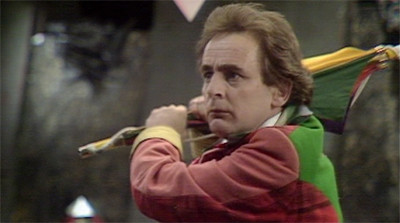 He's got an umbrella and he's not afraid to use it! Sylvester McCoy as the Seventh Doctor brandishes an umbrella, a quirky and unexpected weapon.
He's got an umbrella and he's not afraid to use it! Sylvester McCoy as the Seventh Doctor brandishes an umbrella, a quirky and unexpected weapon.
To label Time and the Rani a “bad story” is almost an understatement. It’s difficult to argue convincingly for its hidden brilliance or to portray it as a triumph against adversity. As television, it falls short, and recommending it as an exemplary Doctor Who adventure would be misleading. Yet, despite its flaws, outright condemnation feels unwarranted. It occupies a peculiar space in Doctor Who history, avoiding the absolute depths reached by other, arguably more ambitious, failures.
One reason for this slightly more lenient perspective lies in the significantly lower stakes at play. Serials like Terror of the Vervoids aimed to redefine the show’s future, to restore Doctor Who‘s standing and audience appeal. The Ultimate Foe was intended to conclude the complex, meta-narrative of the “Trial of a Time Lord” season, and to emphatically assert the enduring value of Doctor Who. Both stories aspired to greatness and fell spectacularly short.
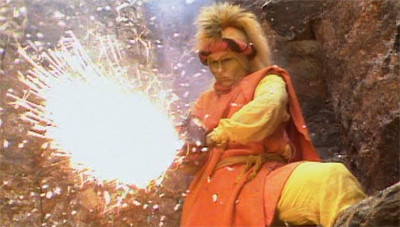 Glamorous Rani! Kate O'Mara as The Rani, striking a pose with vibrant and theatrical makeup, showcasing the villain's flamboyant style.
Glamorous Rani! Kate O'Mara as The Rani, striking a pose with vibrant and theatrical makeup, showcasing the villain's flamboyant style.
Time and the Rani, in contrast, makes no such grand claims. By this point, following the protracted and often convoluted “Trial of a Time Lord” season, cancellation seemed a very real possibility. Time and the Rani doesn’t pretend to be a heroic endeavor that will rescue the show, silence critics, or chart a bold new course. It operates on a much more modest level.
The production challenges surrounding Time and the Rani are well-documented. The dismissal of Colin Baker from the Doctor role between seasons by Michael Grade cast a long shadow over the production. Baker himself expressed his dismay and frustration in an interview:
I couldn’t take (being sacked) in, it was such a shock. I’d fought so hard for the show, I was stunned. What I couldn’t accept is that Grade didn’t have the guts to tell me man-to-man. If I knew why I was sacked then I would feel better about it all. But I got fobbed off with excuses about Grade thinking three years as Dr. Who was long enough. The fact is I only made 26 episodes before he cancelled the show. When it started again there were only 14 episodes. Hardly a long run, is it? All I wanted was a proper explanation. Many people believe, as I do, that I have been treated shabbily.
Colin Baker declined to film the regeneration scene, resulting in the story opening with Sylvester McCoy’s Seventh Doctor already regenerated, albeit disoriented and wearing a rather conspicuous blonde wig – a less than seamless transition.
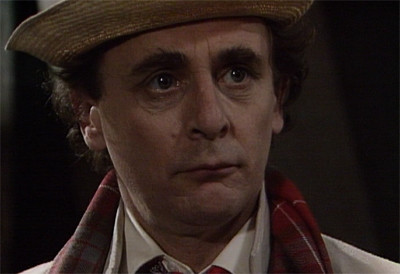 The real McCoy… Sylvester McCoy in his early scenes as the Doctor, wearing a blonde wig as a humorous nod to the regeneration process.
The real McCoy… Sylvester McCoy in his early scenes as the Doctor, wearing a blonde wig as a humorous nod to the regeneration process.
These circumstances created a decidedly inauspicious start to the season. However, the lowered expectations become a crucial factor in evaluating Time and the Rani. The serial simply needed to function as four episodes of Doctor Who introducing Sylvester McCoy. Its primary objective was merely to fill approximately an hour and forty minutes of airtime, touch upon familiar Doctor Who elements, and signal to audiences that the show was still in production.
This is, undeniably, a remarkably low bar. And truthfully, Time and the Rani only just manages to clear it. While still falling short of any genuine greatness, its failure is not as catastrophic as the preceding missteps from writers Pip and Jane Baker. This perhaps explains why it doesn’t elicit the same level of vehement dislike as some other poorly received serials. It might be a flawed story, but assessed against its limited ambitions, it’s not as dramatic a failure as its immediate predecessors.
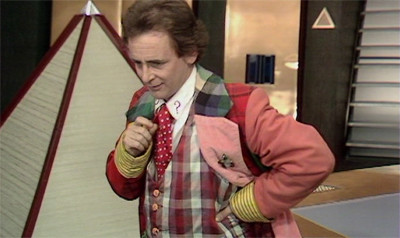 Note to self: find decent tailor… The Seventh Doctor in his initial, somewhat mismatched costume, humorously suggesting the need for a wardrobe upgrade.
Note to self: find decent tailor… The Seventh Doctor in his initial, somewhat mismatched costume, humorously suggesting the need for a wardrobe upgrade.
Of course, hindsight provides a clearer perspective. The season following Time and the Rani generally marked an improvement, paving the way for a period of renewed ambition for Doctor Who. Furthermore, Time and the Rani represents the final script contributed by Pip and Jane Baker to the series – a fact that offers a degree of relief after three consecutive stories penned by the duo. While acknowledging the challenges of scriptwriting and production, the storytelling style of Pip and Jane Baker had become a point of contention for many viewers.
It’s important to offer a balanced view of the Bakers’ contributions. Time and the Rani, much like their work on the concluding part of The Ultimate Foe, was a last-minute effort to salvage a story under considerable time pressure. Pip Baker himself acknowledged the rushed and uncertain nature of the production, noting the confusion at various levels:
We were well into the story when we were shown a video of Sylvester – we had to find a way of (a) regenerating the Doctor, and (b) finding a character for him. John asked for a pre-credit teaser. All of us felt we couldn’t go straight into the story. If we had to regenerate in this way, we needed to start with it, then have a full stop and then start the story. You couldn’t open with Sylvester’s titles otherwise, it would have looked silly.
While the definition of what “looks silly” in Doctor Who is subjective, the chaotic production context is undeniable.
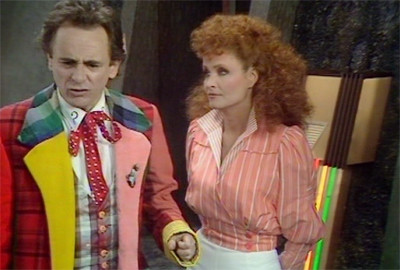 Well, things have certainly changed… Mel and the newly regenerated Doctor in a scene highlighting the immediate aftermath of the Doctor's transformation.
Well, things have certainly changed… Mel and the newly regenerated Doctor in a scene highlighting the immediate aftermath of the Doctor's transformation.
Despite reservations about Terror of the Vervoids and their interpretation of Robert Holmes’ Ultimate Foe script, in Time and the Rani, the Bakers seem to operate within their limitations. Character development, a known weakness, is strategically downplayed. The prospect of Pip and Jane Baker defining the essence of a new Doctor was understandably concerning. Therefore, Time and the Rani cleverly sidesteps this challenge by largely avoiding any substantial exploration of the Seventh Doctor’s personality in its initial stages.
Instead, the opening act of Time and the Rani moves swiftly, with the Doctor’s immediate capture and induced amnesia serving as a plot device to defer deeper character work. This allows Sylvester McCoy and Kate O’Mara, as the Rani, to engage in a somewhat bizarre and dislocated dynamic, playing out a distorted version of the Doctor-companion relationship. The Doctor’s memory loss, attributed to regeneration side-effects (“I must be suffering from post-regeneration amnesia”), becomes a plot-driven necessity rather than a character-driven exploration.
The closest hint at characterization is the Doctor’s use of malapropisms. “A bad workman always blames his fools,” he quips at one point, and later, “Absence makes the nose grow longer.” Beyond these quirks and McCoy’s physical performance, a clear sense of the Seventh Doctor’s persona remains elusive. However, the script integrates this lack of definition into the narrative itself, a somewhat ingenious maneuver.
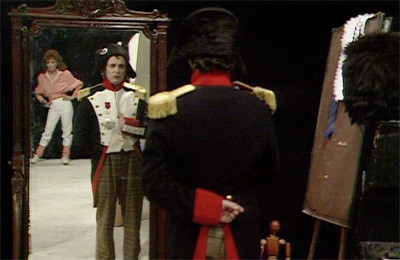 Suits you, sir! The Seventh Doctor in his more finalized and recognizable costume, complete with question marks and hat.
Suits you, sir! The Seventh Doctor in his more finalized and recognizable costume, complete with question marks and hat.
This amnesia plot is, undeniably, a narrative cheat. It’s a way to circumvent the Bakers’ limitations in writing nuanced character development, particularly for a newly regenerated Doctor. By marginalizing the regeneration’s impact on personality, they sidestep a potentially problematic area. Yet, this narrative maneuver is executed with a certain confidence that is almost admirable in its audacity. This element likely contributes to a more lenient view of Time and the Rani.
Furthermore, the portrayal of the Seventh Doctor is deliberately contrasted with his predecessor, the controversial Sixth Doctor. The Rani, disguised as Mel, observes, “There’s not a lot to remember. The benevolent climate has induced lethargy. They’ve failed to realise their full potential.” The Doctor responds, “Rather a harsh judgement, Mel.” She retorts, “Not mine. Yours.” While seemingly her opinion, the sentiment echoes the more abrasive and judgmental tone sometimes associated with Colin Baker’s Sixth Doctor.
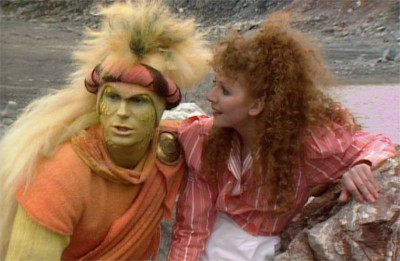 Mel has a sudden urge to see the Lion King on stage… Mel Bush with an elaborate headdress, a visually striking but somewhat incongruous element of the Rani's manipulations.
Mel has a sudden urge to see the Lion King on stage… Mel Bush with an elaborate headdress, a visually striking but somewhat incongruous element of the Rani's manipulations.
His costume, too, appears more understated compared to the Sixth Doctor’s flamboyant attire, perhaps acknowledging the Sixth Doctor’s look as a misstep. The Seventh Doctor, upon settling on his outfit, declares, “Ah, thank goodness in this regeneration I’ve regained my impeccable sense of haute couture.” A humorous line, but with an underlying acknowledgment of the previous costume’s reception.
The Seventh Doctor’s outfit, while toned down, still incorporates the question mark motif, suggesting a continued attempt to brand the Doctor in a more overtly symbolic way. Reportedly inspired by golfing attire, it suits McCoy well, projecting an image of a whimsical traveler through time and space. Ideally, Doctor costumes should offer some visual flexibility within a consistent theme, as seen with previous Doctors like Tom Baker, Jon Pertwee, and David Tennant, who all possessed distinct yet recognizable styles.
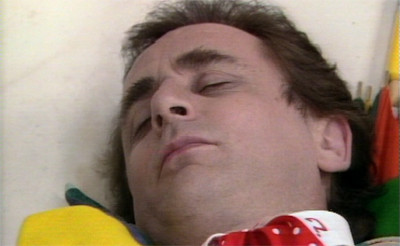 Meet the new Doc… A full shot of Sylvester McCoy as the Seventh Doctor in his costume, showcasing the question marks and hat.
Meet the new Doc… A full shot of Sylvester McCoy as the Seventh Doctor in his costume, showcasing the question marks and hat.
However, Time and the Rani remains a Pip and Jane Baker script, characterized by its awkwardness, generic plot points, and blandness. Ironically, Time and the Rani stands out as somewhat atypical of the McCoy era as a whole, indicating that the Bakers’ style was not entirely aligned with incoming script editor Andrew Cartmel’s vision for the show. Cartmel himself noted:
The thing about Pip and Jane is structurally their stuff is very sound and they touch all the bases and write well-carpentered stories. But the things I was looking for were much wackier, much more off beat; much darker, much sharper, much harder. They came from a background of writing a lot of children’s stuff, a lot of Gerry Anderson. So my style wasn’t their style. The other problem was I think they perceived me as this new kid on the block, they didn’t know if I knew anything.
Cartmel’s assessment, while generous in praising the Bakers’ structural competence, highlights the stylistic divergence between their work and the direction he envisioned for Doctor Who.
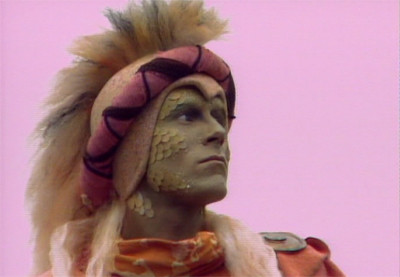 For a world where eighties hair never went out of fashion! The Rani's world, with its futuristic but somewhat dated aesthetic, reflecting 1980s production values.
For a world where eighties hair never went out of fashion! The Rani's world, with its futuristic but somewhat dated aesthetic, reflecting 1980s production values.
The Bakers’ writing often leaned towards a more conservative approach. While generally apolitical, Time and the Rani contains a moment that hints at a conservative, even Thatcherite, perspective. Ikona’s line, “They’ve become spoon-fed drones. There’s no need for them to strive. An indulgent system provides all,” sounds suspiciously like a critique of the welfare state, echoing rhetoric prevalent during the Thatcher era. This political undertone feels somewhat out of sync with Doctor Who‘s generally more liberal leanings and certainly contrasts with the overtly anti-Thatcher themes that would emerge in Cartmel’s era.
 The brains of the operation… The Rani overseeing her scientific experiments, emphasizing her role as the story's primary antagonist and scientific mastermind.
The brains of the operation… The Rani overseeing her scientific experiments, emphasizing her role as the story's primary antagonist and scientific mastermind.
Beyond the political undercurrents, Time and the Rani exemplifies a middle-of-the-road, conventional Doctor Who style that Cartmel aimed to move away from. Mel Bush, for instance, embodies the archetypal companion, functioning more as a plot device than a fully realized character. Her characterization, or lack thereof, is partly attributable to the Bakers, who wrote her first three serials.
However, Mel’s generic nature also holds a certain appeal. She represents a point of normalcy during a period of upheaval for the series. Yet, her very genericness necessitated her eventual departure for the show to evolve. In Time and the Rani, Mel’s primary function is to run and scream – a limited portrayal. The series never delves into Mel’s backstory; she simply exists as the companion.
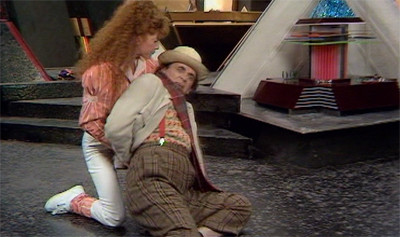 His characterisation is hard to pin down… The Seventh Doctor in a thoughtful pose, reflecting the initial ambiguity and lack of definition in his character portrayal.
His characterisation is hard to pin down… The Seventh Doctor in a thoughtful pose, reflecting the initial ambiguity and lack of definition in his character portrayal.
Time and the Rani offers fleeting hints that Mel might possess some prior expertise, with the Rani using her for computer programming and the Doctor later referring to her as a “computer expert.” However, this remains a generic descriptor, failing to provide a meaningful backstory or inform Bonnie Langford’s performance in any substantial way. The label could have been anything equally vague without altering our understanding of Mel.
Tellingly, even several stories later, Mel’s scream remains a recurring trope, often used for cliffhangers. Her debut in Terror of the Vervoids featured a scream perfectly synchronized with the closing theme – a gag that becomes somewhat disheartening in retrospect. It reinforces the perception of Mel as primarily defined by her capacity to scream, fitting into a simplistic and generic notion of a companion’s role, rather than offering depth or complexity.
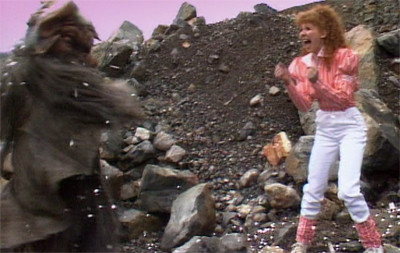 Mel in her natural state… Mel Bush screaming, highlighting the character's frequent and somewhat stereotypical use of screams in moments of peril.
Mel in her natural state… Mel Bush screaming, highlighting the character's frequent and somewhat stereotypical use of screams in moments of peril.
The dialogue in Time and the Rani also presents challenges. While Sylvester McCoy’s vocal delivery is undeniably strong and engaging, lending a certain gravitas even to the villain’s name, “Rani,” the script often saddles him with clunky lines. Even McCoy’s enunciation struggles to make phrases like “a hologram! as substantial as the Rani’s scruples!” sound convincing.
In conclusion, Time and the Rani is undeniably flawed. However, it’s not the nadir of Doctor Who. Viewed from a contemporary perspective, knowing the series’ trajectory towards stories like Remembrance of the Daleks and The Curse of Fenric, Time and the Rani appears as a minor blip. In 1987, however, following a string of underwhelming stories, it likely signaled more of the same.
 Sylvester McCoy provides the lion's share of the episode's charm. Sylvester McCoy as the Seventh Doctor, showcasing his physical and vocal performance style that brought charm to the role.
Sylvester McCoy provides the lion's share of the episode's charm. Sylvester McCoy as the Seventh Doctor, showcasing his physical and vocal performance style that brought charm to the role.
The extended break before the season premiere meant audiences had endured ten months since a Doctor Who serial not written by Pip and Jane Baker. Experiencing their three consecutive stories in close succession, even interspersed with other content, can be a somewhat arduous experience. For viewers at the time, this fatigue must have been amplified. Positioning Time and the Rani as the season opener might have suggested a continuation of this style, a potentially disheartening prospect.
Instead, Time and the Rani functions as a final echo of a confused and troubled era of Doctor Who. The subsequent year ushered in a period of experimentation and reinvigoration under Andrew Cartmel’s script editorship. While Cartmel was relatively inexperienced, his enthusiasm was precisely what Doctor Who desperately needed. His first season would be uneven, but the missteps that followed proved far more engaging and innovative than much of what had preceded them.
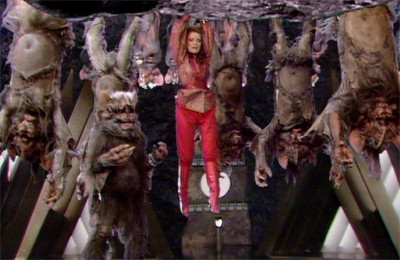 Hang on in there! The Seventh Doctor holding onto the TARDIS console, a visual metaphor for the show itself persevering through challenging times.
Hang on in there! The Seventh Doctor holding onto the TARDIS console, a visual metaphor for the show itself persevering through challenging times.
Time and the Rani, in hindsight, is a fleeting anomaly. It doesn’t inspire strong negative reactions, especially considering the more rewarding Doctor Who adventures that followed. It serves as a transitional piece, a flawed but ultimately necessary step towards a brighter future for the series.
[

